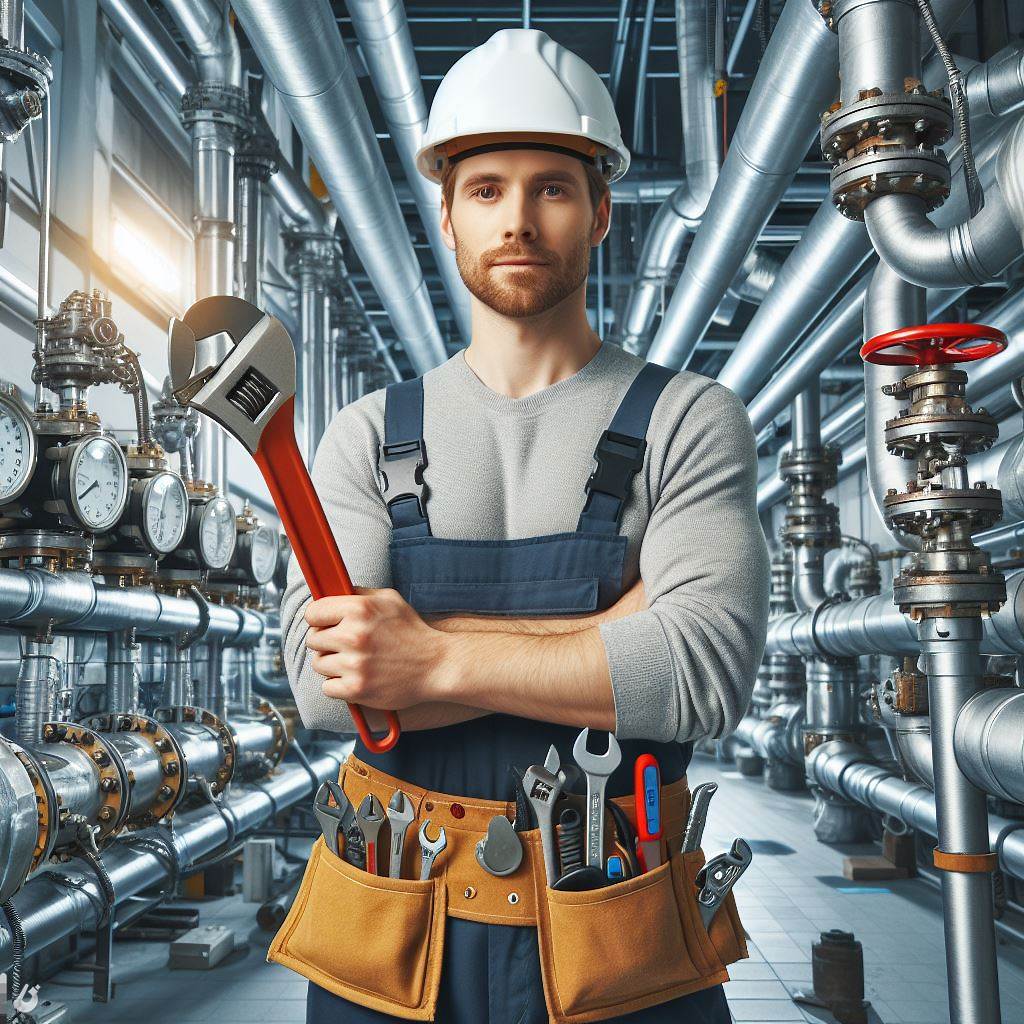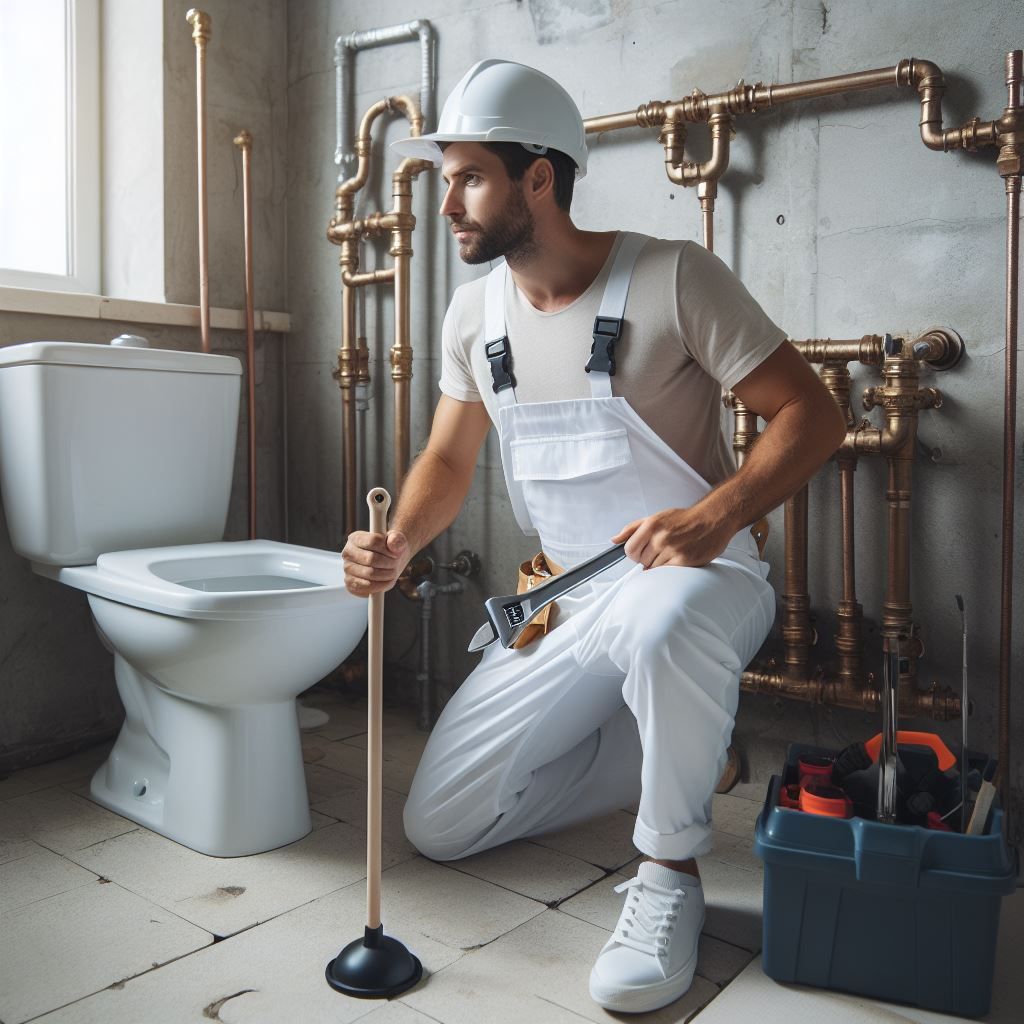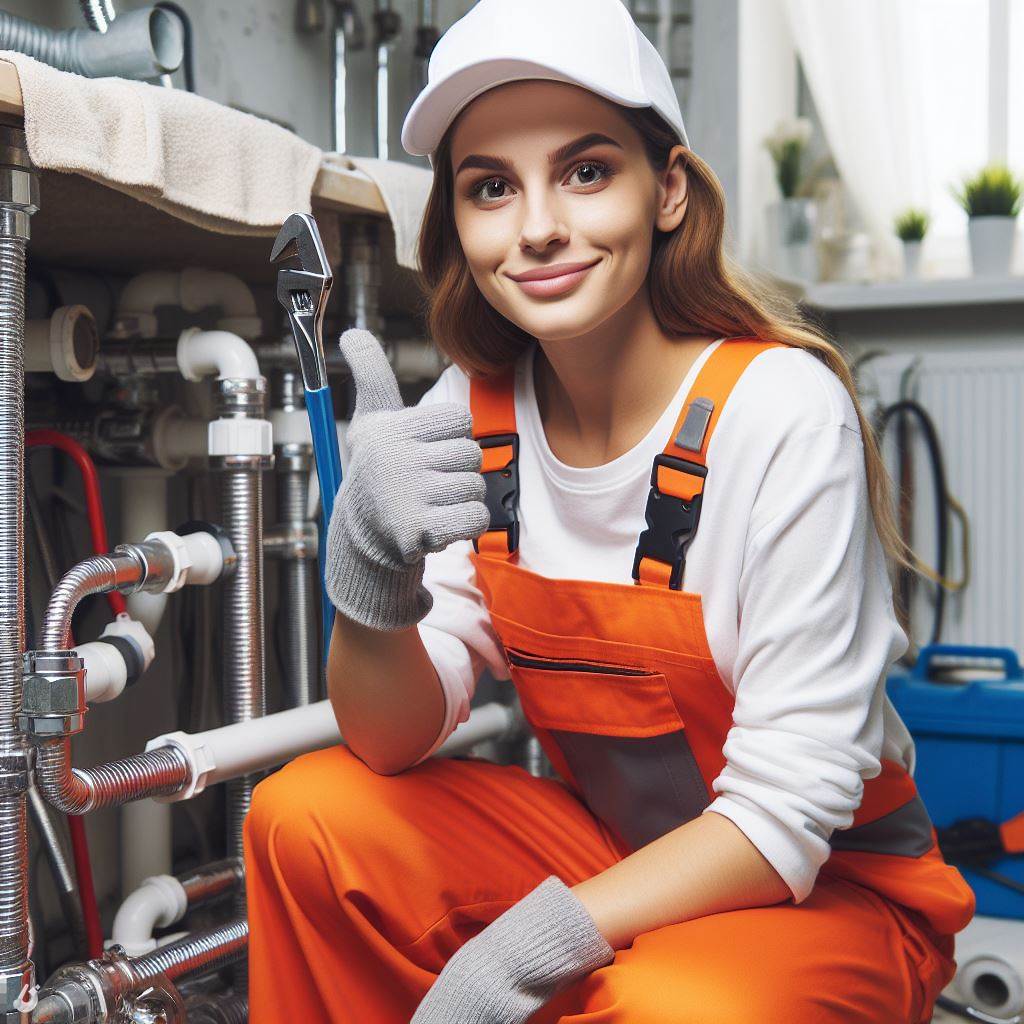Introduction
Safety is of utmost importance in the plumbing profession.
As plumbers work with hazardous materials and operate heavy machinery, following safety protocols is essential.
This blog section will discuss important safety tips for plumbers in Canada, highlighting the potential risks and necessary precautions.
Plumbers encounter various risks such as exposure to harmful chemicals, electrical hazards, and working in confined spaces.
Addressing these dangers is crucial for the well-being of the plumbers and the success of their projects.
By implementing proper safety measures, accidents and injuries can be minimized or even avoided.
To ensure safety, plumbers should always wear appropriate protective gear, including gloves, goggles, masks, and sturdy footwear.
It is important to understand the properties of the chemicals they handle and to follow proper handling and disposal procedures.
Another critical aspect is electrical safety. Plumbers must ensure that power sources are turned off before working on any electrical components.
Proper insulation and grounding of electrical systems are vital to prevent electric shocks.
Working in confined spaces like crawl spaces or boiler rooms poses additional risks.
Plumbers must be aware of potential hazards such as poor ventilation, limited entry and exit points, and the presence of toxic gases.
Adequate ventilation and accessing confined spaces with a buddy system are essential safety precautions.
Regular safety training and staying updated with the latest industry regulations is paramount for plumbers.
By prioritizing safety, plumbers can protect themselves and others while delivering high-quality plumbing services in Canada.
Essential Personal Protective Equipment (PPE)
In order to ensure the safety of plumbers, it is essential to have the proper Personal Protective Equipment (PPE).
Plumbers encounter various hazards on the job, making it crucial to have the necessary protective gear at all times.
Explanation of the necessary PPE for plumbers:
- Safety goggles: Protect your eyes from debris, chemicals, and potential splashes.
- Respirators: Prevent inhalation of harmful chemicals, dust, or fumes.
- Protective gloves: Shield your hands from sharp objects, chemicals, and hot substances.
- Steel-toe boots: Protect your feet from heavy objects or potential impact.
- Hard hat: Safeguard your head from falling objects and overhead hazards.
- Protective clothing: Wear coveralls or work shirts and pants to guard against spills and contaminants.
- Earplugs or earmuffs: Shield your ears from loud noises, reducing the risk of hearing loss.
These are just some of the essential PPE items that plumbers should have readily available.
Depending on the specific job and potential hazards, other protective gear may need to be considered.
Emphasizing the importance of using PPE:
PPE is vital in minimizing the risks and injuries that plumbers may face on a daily basis.
It serves as a protective barrier, reducing exposure to hazardous elements, and improving overall safety.
Failure to wear appropriate PPE can lead to serious consequences, including eye injuries, respiratory problems, burns, cuts, and even long-term health issues.
Plumbers must prioritize their safety by always utilizing PPE.
Tips on selecting and maintaining PPE
- Choose high-quality PPE from reputable manufacturers to ensure reliability and effectiveness.
- Ensure proper fit to maximize protection. Ill-fitting PPE can compromise safety.
- Regularly inspect and maintain PPE for damages. Replace worn-out or damaged gear promptly.
- Train all plumbers on the correct usage and maintenance of their specific PPE.
- Provide necessary storage and care instructions to prolong the lifespan of the equipment.
- Keep track of PPE inventory to ensure availability and replenishment when needed.
- Encourage plumbers to report any issues with their PPE and provide timely replacements.
By following these tips, plumbers can ensure they have the right PPE for the job and maintain its effectiveness.
Remember, investing in Personal Protective Equipment is investing in the safety and well-being of plumbers.
Unlock Your Career Potential
Visualize a clear path to success with our tailored Career Consulting service. Personalized insights in just 1-3 days.
Get StartedThrough the proper use and maintenance of PPE, accidents and injuries can be greatly minimized, making for a safer work environment.
Read: Apprenticeship in Plumbing: A Canadian Overview
Hazard Identification and Risk Assessment
In order to ensure the safety of plumbers in Canada, it is crucial to identify potential hazards that may arise during their work.
Conducting a risk assessment plays a vital role in mitigating these risks effectively.
Need for Hazard Identification
Plumbers need to identify hazards to prevent accidents, injuries, and even fatalities.
This includes recognizing potential dangers in the work environment, which can be electrical, chemical, or physical in nature.
- Electric hazards: Exposed wiring, defective power tools, or faulty electrical equipment.
- Chemical hazards: Exposure to harmful substances like solvents, asbestos, or mold.
- Physical hazards: Slippery surfaces, poor lighting, or working at heights without proper fall protection.
Identifying these hazards allows plumbers to implement preventive measures and ensure a safe working environment.
Conducting a Risk Assessment
After identifying the hazards, it is essential to assess the level of risk associated with each one.
Plumbers should follow these steps:
- Evaluate the likelihood of the hazard occurring and the potential consequences if it does.
- Rank the risks based on their severity and prioritize the most significant ones.
- Implement preventive measures to reduce or eliminate the identified risks.
- Regularly review and update the risk assessment to account for any changes in the work environment.
By performing a thorough risk assessment, plumbers can take appropriate precautions and minimize the potential for accidents and injuries.
Common Hazards Faced by Plumbers in Canada
Plumbers in Canada encounter various hazards while carrying out their tasks. Some common ones include:
- Exposure to asbestos: Old buildings may still have asbestos-containing materials, requiring proper handling and protection.
- Falls from heights: Plumbing work often involves working on elevated surfaces, necessitating proper fall protection equipment.
- Confined spaces: Plumbers may need to work in tight spaces with poor ventilation, leading to suffocation risks.
- Chemical exposures: Contact with corrosive chemicals or solvents can cause severe skin or respiratory irritation.
- Electrical dangers: Working with live electrical systems or faulty equipment can lead to electric shocks or fires.
Plumbers must be aware of these hazards and consistently follow safety protocols to protect themselves and their colleagues.
In short, hazard identification and risk assessment play fundamental roles in ensuring the safety of plumbers in Canada.
By recognizing potential dangers and conducting thorough assessments, plumbers can effectively minimize risks and create a safer work environment for themselves and others.
Read: Plumbing Codes in Canada: What You Should Know
Proper Use of Tools and Equipment
Using tools and equipment correctly is of utmost importance in ensuring the safety of plumbers.
Here are some tips to keep in mind:
The significance of using tools and equipment correctly
- Always use the right tool for the job to prevent accidents and damage.
- Read and follow the manufacturer’s instructions for proper tool usage.
- Inspect tools regularly for any signs of wear or damage before using them.
- Using tools correctly increases efficiency, reduces fatigue, and enhances overall work quality.
- Adhere to safety guidelines to avoid injuries and enhance workplace productivity.
Tips for handling plumbing tools safely
- Wear appropriate personal protective equipment such as gloves, goggles, and ear protection.
- Hold tools firmly and securely to maintain control during use.
- Avoid carrying tools in pockets as it increases the risk of injury.
- Use caution when handling sharp or pointed tools to prevent cuts or puncture wounds.
- Keep cutting tools properly sharpened to minimize the risk of slips or accidents.
Maintenance guidelines for maintaining equipment in top condition
- Regularly clean and lubricate tools to keep them in optimal working condition.
- Store tools in a clean and dry place to prevent rust and damage.
- Check cords and cables for any fraying or damage, and replace them if necessary.
- Inspect equipment for loose or missing parts and get them repaired or replaced promptly.
- Keep power tools away from water sources and use them in dry conditions only.
Proper use and maintenance of tools and equipment not only improve safety but also extend their lifespan and efficiency.
Following these guidelines ensures the smooth operation of plumbing tasks and reduces the risk of accidents or injuries.
Remember, safety should always be the top priority in any profession, including plumbing.
Read: Essential Tools Every Canadian Plumber Needs
Safe Work Practices
Steps to minimize the risk of accidents and injuries
- Follow safe work practices at all times to ensure your own well-being and the safety of others.
- Minimize the risk of accidents and injuries by adhering to established safety protocols and guidelines.
- Always wear the appropriate personal protective equipment (PPE) to shield yourself from potential hazards.
- Prioritize regular maintenance of tools and equipment to keep them in optimal working condition.
- Ensure a clutter-free work area to prevent trips, slips, and falls that can lead to serious injuries.
- Use ladders and scaffolding properly by checking their stability and weight capacity before each use.
- Avoid rushing tasks or taking shortcuts as they can compromise your safety and result in accidents.
- Communicate effectively with colleagues and clients to ensure everyone understands the safety measures in place.
- Attend regular safety training sessions to stay updated on new practices and technologies in the plumbing industry.
- Seek continuous education opportunities to enhance your knowledge and skills regarding safety practices.
- Conduct thorough risk assessments before starting any plumbing project to identify potential hazards.
- Have a clear understanding of emergency procedures and know the location of fire extinguishers, first aid kits, and emergency exits.
- Avoid working alone in hazardous environments and always inform someone about your whereabouts.
- Implement proper lifting techniques when handling heavy objects to prevent strains and back injuries.
- Keep your work area well-lit to ensure good visibility and reduce the risk of accidents caused by poor lighting.
By following these safe work practices, you can minimize the risk of accidents and injuries while working as a plumber.
Remember, safety should always be your top priority!
Read: Canadian Plumbers’ Earnings: Expectations vs Reality

Health and Safety Regulations
Overview of Canadian health and safety regulations specific to plumbers
Plumbing is a profession that demands physical labor and involves potential hazards.
To safeguard plumbers’ health and well-being, Canada has established specific health and safety regulations.
These regulations outline the legal requirements and obligations that plumbers must comply with to ensure their safety.
Discussion on the legal requirements and obligations
Firstly, plumbers need to be aware of their legal obligations. Understanding the regulations and their implications is crucial to maintain compliance.
The regulations cover various aspects, including personal protective equipment, hazard communication, and proper handling of tools and materials.
Plumbers must prioritize their safety and that of their colleagues on every worksite.
Advising plumbers to stay up to date with the current regulations
Secondly, staying up to date with the current health and safety regulations is of utmost importance.
These regulations are periodically updated to improve safety practices and address new risks.
Plumbers must actively seek information regarding any amendments or additions to the regulations that pertain to their work.
By complying with the health and safety regulations, plumbers can prevent workplace accidents, injuries, and potentially life-threatening situations.
Adherence to these regulations also ensures that plumbers are legally protected from any potential liability in case of mishaps.
Benefits of Implementing Health and Safety Regulations
In addition to legal obligations, implementing health and safety regulations brings numerous benefits to plumbers and their businesses.
By providing a safe working environment, these regulations reduce the risk of accidents and injuries, protecting the physical well-being and livelihoods of plumbers.
Furthermore, compliance with health and safety regulations showcases professionalism and a commitment to quality work.
Plumbers who prioritize safety gain trust and credibility from clients and colleagues, further enhancing their reputation and attracting more business opportunities.
Moreover, adhering to regulations helps plumbers avoid potential liability and legal complications resulting from non-compliance.
In situations where accidents or injuries occur despite precautionary measures, complying with the regulations ensures that plumbers have legally followed the required safety protocols.
In a nutshell, Canadian health and safety regulations specific to plumbers are crucial for ensuring their well-being and maintaining a safe working environment.
Plumbers must be aware of their legal obligations and stay updated with the current regulations.
By complying with these regulations, plumbers can protect themselves, their colleagues, and their businesses while reaping the benefits of a safe working environment.
You Might Also Like: Welding Tools and Equipment: A Beginner’s Guide
Gain More Insights: Health and Safety for Mechanics in Canada
First Aid and Emergency Preparedness
Plumbers often find themselves in high-risk situations that require them to be prepared for emergencies.
Here, we will highlight the need for plumbers to be ready for any unforeseen circumstances and the importance of first aid training.
We will also provide some tips on how to develop an emergency response plan to handle potential emergencies effectively.
The Need for Plumbers to be Prepared for Emergencies
Plumbers work with various tools, machinery, and hazardous materials, making them susceptible to accidents and injuries.
Being prepared for emergencies is crucial for their safety and the well-being of their clients.
By being proactive in emergency preparedness, plumbers can minimize risks and potential damages.
The Importance of First Aid Training
First aid training is a lifesaver – literally. Plumbers should consider obtaining first aid certification to handle emergency situations effectively.
With proper training, they can administer initial aid and stabilize an injured person until professional medical assistance arrives.
First aid training equips plumbers with essential skills, including CPR, wound care, and understanding common workplace hazards.
Tips for Developing an Emergency Response Plan
To ensure plumbers are well-prepared for emergencies, it is crucial to have a comprehensive emergency response plan in place.
Here are some tips on how to develop an effective plan:
Identify Potential Emergencies
Thoroughly assess the plumbing work environment and identify potential emergencies.
This could include hazards such as chemical spills, gas leaks, electrical accidents, or serious injuries to themselves or others.
Understanding the specific risks helps in creating an appropriate response plan.
Establish Communication Protocols
Communication is key during emergencies. Establish clear communication protocols among team members, clients, and emergency services.
Ensure everyone is aware of emergency contact numbers, communication channels, and procedures to follow in case of an emergency.
Train Employees on Emergency Procedures
Regularly conduct training sessions to educate plumbers on emergency procedures and protocols.
Teach them how to respond quickly and efficiently to different emergency scenarios.
Emphasize the importance of staying calm, following established protocols, and prioritizing safety.
Create an Emergency Equipment Checklist
Compile a comprehensive checklist of emergency equipment required on job sites.
This may include first aid kits, fire extinguishers, eye wash stations, and personal protective equipment.
Regularly inspect and replenish these supplies to ensure they are readily available when needed.
Establish Evacuation Plans
Develop evacuation plans specific to different job sites or work environments.
Clearly mark evacuation routes, exits, and assembly points.
Conduct drills periodically to ensure everyone is familiar with the evacuation procedures, reducing panic and increasing efficiency during emergencies.
Update and Review the Plan
Emergency response plans should be periodically updated and reviewed to reflect changes in the work environment and potential risks.
Collaborate with employees to gather feedback on the effectiveness of the plan and make necessary improvements.
Being prepared for emergencies is a critical component of a plumber’s job.
First aid training and the development of an emergency response plan are essential for ensuring the well-being and safety of plumbers, as well as others around them.
By implementing these tips, plumbers can effectively handle emergencies, reduce risks, and provide top-notch service to their clients.
Safety Culture and Communication
Exploring the Significance of Fostering a Safety Culture Within Plumbing Companies
- Creating a safety culture promotes a mindset where safety is valued and prioritized in all activities.
- It helps establish clear expectations for safety practices and behavior among employees.
- A safety culture reduces the likelihood of accidents, injuries, and work-related illnesses.
- It enhances the overall reputation of the plumbing company, attracting clients who prioritize safety standards.
- Promoting a safety culture is not a one-time effort but rather an ongoing commitment to continuous improvement.
Encouraging Open Communication Regarding Safety Concerns
- Encouraging open communication allows employees to express their safety concerns without fear of reprisal.
- Establishing effective channels of communication promotes the exchange of safety-related information and ideas.
- Regular safety meetings and toolbox talks provide opportunities for discussing potential hazards and risk mitigation strategies.
- Employees should feel comfortable reporting near misses, incidents, or unsafe conditions to promote continuous improvement.
- Listening and responding to safety concerns promptly demonstrates that employee well-being is a top priority.
Sharing Strategies for Promoting Safety Throughout the Workplace
- Provide adequate training to ensure all employees are knowledgeable about safety protocols and procedures.
- Regularly review and update safety policies to align with industry standards and regulatory requirements.
- Foster a proactive approach by encouraging employees to identify potential safety hazards and suggest improvements.
- Implement a reporting system for observing, documenting, and resolving safety concerns promptly.
- Recognize and reward employees who consistently adhere to safety practices and contribute to a safe work environment.
Fostering a safety culture within plumbing companies is essential for protecting employees and ensuring a successful business.
By prioritizing safety, encouraging open communication, and sharing strategies for promoting safety, companies can create a workplace where employees feel valued and protected.
Remember, safety is everyone’s responsibility, and a proactive approach to safety will yield long-term benefits for both employees and the company as a whole.
Conclusion
This blog post discussed important safety tips for plumbers in Canada.
Throughout the blog post, we emphasized the significance of prioritizing safety in the plumbing profession.
We highlighted key points such as wearing the appropriate personal protective equipment, regularly inspecting and maintaining tools and equipment, and employing safe work practices.
We also stressed the importance of proper training and certification for plumbers to ensure they have the necessary skills and knowledge to carry out their work safely.
By following these safety guidelines, plumbers can minimize the risk of accidents, injuries, and even fatalities in their day-to-day tasks.
Overall, safety should always be the top priority for plumbers, as it not only protects them but also ensures the well-being of their clients and the general public.
By adhering to these safety measures, plumbers can maintain a safe working environment and establish a strong reputation for professionalism and reliability in the industry.
Awareness, education, and implementation of safety practices are crucial for all plumbers to perform their duties effectively while reducing potential hazards.
By keeping safety at the forefront, plumbers can safeguard themselves, their clients, and the community.




